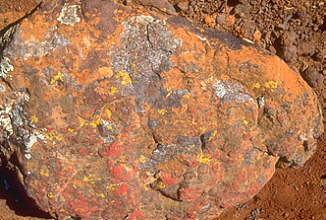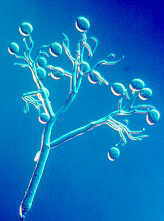
Fungi are no plants. They can, just like plants (Plantae) and animals (Animalia), be classified as an original kingdom, that has, like the other two, developed from eucaryotic, single-celled protists (kingdom: Protista). Plants and most fungi share no common homologous structures besides those already conserved at the level of protists. These are:
| the existence of nuclei, the condensation of DNA with the help of histones, and | |
| the presence of actin and tubuline (and thus also of amoeboid movements of cells and of flagellar movements). |
These kingdoms do nevertheless share analogies (convergences, parallel developments) that are often and wrongly cited as proofs for the relationship of plants and fungi. Three similarities are especially often referred to:
Both plant and fungal cells are enclosed by a cell wall while animal cells have no such characteristic. This is true, and cell walls exist in prokaryotes (bacteria, blue-green algae), too. The walls of all three mentioned kingdoms have, nevertheless, different molecular compositions (they contain different molecular classes), their biosynthetic pathways and the way of their cellular growths are different. They are therefore not homologous.
Alterations of generations are known both in the plant and the fungal kingdom, that of fungi is similar to some that of some red algae. This is true, too, but alterations of generations occur also in the animal kingdom (with coelenterates, for example). In addition, it is known today that the phenomenon ‘alteration of generation’ has developed several times independently in the plant kingdom alone.
Plants and fungi are sessile, animals (usually) mobile. When referring to ARISTOTLE, corals and see anemones would have to be counted among plants, too.
The differences between the two kingdoms are graver. The different feeding habits are very important. Plants are able to use the energy of the sun light. They are autotrophic, i.e. their existence and their growth is (usually) independent of the activities of other living creatures. Fungi are always heterotrophic: they depend on the presence of organic material. Users of dead organic material (dead cells, reduced carbon and nitrogen compounds rich in energy) are called saprophytes. Parasites, in contrast, attack living cells. Both types exist in other kingdoms, too.

Sporangiophore of Peronospora |
Oomycetes:
Constitute oomycetes a missing link or a group that cannot be counted among
fungi at all? Oomycetes
contain - in contrast to all other fungi – cell walls out of cellulose,
their zoospores have two heterokont flagellae, and their thallus resembles
that of some siphonal algae (Vaucheria, for example). Are they related?
Have they lost their chloroplasts and have they secondarily changed to a
saprophytic lifestyle? Some observations, among them the data gained in molecular
biology (rRNA analyses), seem to support this assumption, but the final
decision about their systematic position has not been taken yet. One example:
Peronospora (downy mildew): A number
of species that cause considerable damage in agriculture belong to this genus. One of them
causes a tuber rot of the potato, another is the cause for a ‘blue mildew’ on tobacco leaves,
and a third species is known as ‘downy mildew’ in viniculture. Peronospora-species
are often – though not always – obligatory parasites. Nearly all of them are
thiamine-heterotrophic (i.e. they require an extern source for the vitamin thiamine in order
to grow)
According to what we know today, primitive plants (especially algae) and blue-green algae as well as primitive fungi have all developed in aquatic biotopes. Dead algae (and procaryotes) and energy-rich compounds given off by them (amino acids, proteins, carbohydrates) form the basis for fungal growth. Living and physiologically active algae are often surrounded by a voluminous gelatine that is rich in nutriments and is therefore also a preferred residence of heterotrophic cells.
The spatial closeness of two organisms promotes the development of mechanisms for the mutual influencing. Destroying of the algae in order to obtain their cell contents is parasitism; the production of antibiotics or other growth-inhibiting substances is a defence mechanism.
The neighbourhood of algae and fungi in an aquatic environment is obviously of advantage only for the fungi, but the situation in terrestrial biotopes is changed. Fungi are especially common in the two uppermost soil layers (horizons A and B). The colonization of soils may originally have occurred after the dying of organisms left a sediment at the ground of inshore waters where fungi and bacteria settled. These nutrient-rich layers reached the earth’s surface by drying up or silting up of the inshore water. They became the biotopes of the first ‘terrestrial’ fungi. Algae had at first only limited chances to survive, since they are dependent both on water and light. Light was available only in the uppermost, only a few millimetre thick layer where also the danger of drying out was greatest. In order to survive ashore, two different evolutionary strategies developed:
The evolution of protections against drying out: multicellularity, development of strengthening elements, upright growth, etc. In short, vascular plants developed.
Associations between single-celled algae and fungi formed. This strategy ( a symbiosis) led to the evolution of lichens.
Vascular plants consist usually of a shoot above ground and an underground root. The latter competes at least partially with the mycelium of fungi (the network consisting of hyphae) for nutriments. Both have nevertheless ecological niches, since plant roots absorb primarily water with dissolved minerals, while fungi absorb water with dissolved organic compounds as well as minerals. A combining and thus a co-operation of plant roots and mycelium of fungi (mycorrhiza) may therefore lead to an optimal usage of nutriment resources. Mycorrhizas are a classic textbook example of a symbiosis, i.e. of a co-existence that is of advantage for both partners. Shoots above ground profit only exceptionally directly from the presence of fungi. A relation between fungi and plant above ground is therefore usually of parasitic nature.
|
|